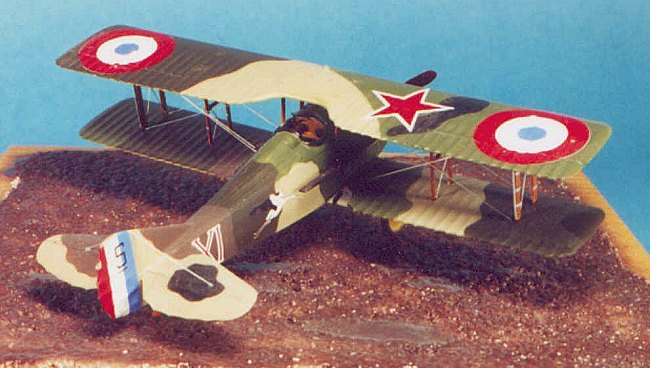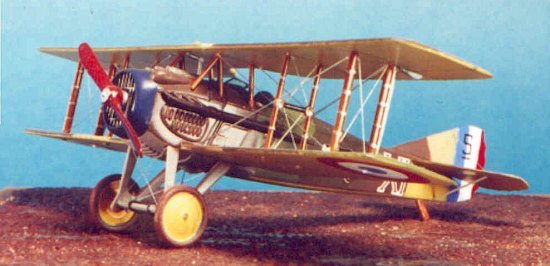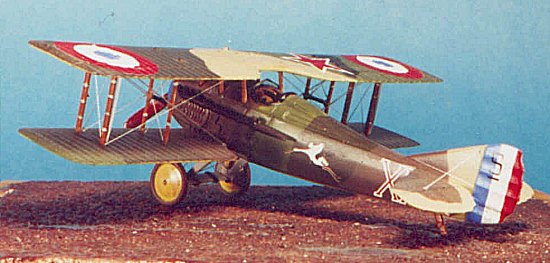
|
KIT: |
Glencoe 1/48 Spad XIII |
|
KIT # |
? |
|
PRICE: |
$9.95 |
|
DECALS: |
Seven versions |
|
REVIEW & |
|
|
NOTES: |

|
HISTORY |
RENE FONCK - THE ALLIED ACE OF ACES
The S.P.A.D. XIII is one of the best-known of the fighters used during the First World War. A more powerful and better-armed development of the S.P.A.D. VII, it was the standard fighter of the French Air Force following its introduction in the late summer of 1917 until the end of the war, as well as the main equipment of the pursuit squadrons of the United States Army Air Service. It additionally equipped units of the Italian Air Force during 1918, though it never completely supplanted the earlier S.P.A.D., which many Italian pilots liked better due to its lighter handling. After the war, the airplane was used by air forces ranging from that of Czechoslovakia to Japan, and remained in first-line service with the U.S.A.S. until the early 1920s.
Rene Fonck:
Captain Wissemann, who claimed to have shot down Guynemer, told his family "Never again will I have to meet an adversary who is half as dangerous as Guynemer." Nineteen days later, on October 17, 1917, Wissemann was shot down in combat by an unknown SPAD pilot named Rene Fonck.
Despite the fact that, with 75 victories, Rene Fonck is the Allied Ace of Aces of the First World War, he is one of the lesser-known aces of that conflict. In part, this is due to the fact that in the Second World War he chose to remain loyal to Vichy France, which tarnished his reputation in his native land during the final years of his life prior to his death in 1952.
Fonck was the polar opposite of Guynemer. Air fighting was to him a science, and he became a master of tactics, spending long hours studying the tactics of his enemies and devising counters to them. Like many of the great aces of the war, he spent the years 1915-17 as a reconnaissance pilot, during which time he had his fair share of adventures and escapes. Once, during the Battle of Verdun, while flying a Voisin, his wingman took a direct hit from anti-aircraft fire and exploded. Shocked, Fonck watched what was left of the wingless fuselage plummet to earth, unwittingly placing himself in the slipstream and falling into a spin from which he only extricated himself some 200 feet above the German lines.
Fonck was posted to the Escadrille les Cigognes on April 25, 1917. On May 3, he shot down one of two enemy two-seaters he caught over the French lines. After avenging Guynemer that October, he destroyed 10 more aircraft that month in only 13.5 hours of flight time. By the end of 1917 his score stood at 19, making him the third-ranking active French ace.
 The last German offensive of the war opened in March 1918. Les Cigognes
were on the Champagne Front, where they faced strong opposition in a battle that
would see one side or the other victorious in a war that had dragged on four
years with no obvious winner. By this time, Fonck's score stood at 27. "All
day long," Fonck wrote his mother, "the air was filled with the roar
of engines. We flew so low that we almost touched the enemy's bayonets, watching
the compact masses of troops melt away before our machine gun fire. The chaos
was terrible. Panic-stricken horses charged in all directions, trampling
soldiers underfoot." Now, for the first time, Fonck and his compatriots saw
the deadly effect of their bullets on human flesh from only a few yards.
The last German offensive of the war opened in March 1918. Les Cigognes
were on the Champagne Front, where they faced strong opposition in a battle that
would see one side or the other victorious in a war that had dragged on four
years with no obvious winner. By this time, Fonck's score stood at 27. "All
day long," Fonck wrote his mother, "the air was filled with the roar
of engines. We flew so low that we almost touched the enemy's bayonets, watching
the compact masses of troops melt away before our machine gun fire. The chaos
was terrible. Panic-stricken horses charged in all directions, trampling
soldiers underfoot." Now, for the first time, Fonck and his compatriots saw
the deadly effect of their bullets on human flesh from only a few yards.
Air power halted the German offensive, even moreso than the last-ditch defense of French and Commonwealth soldiers who died at their positions. By April, the Allied squadrons began a field day against their German opponents. By April 25, one year after entering combat as a pilote de chasse, Fonck's score stood at 36. He was meticulous in his approach to air fighting, constantly devising new tactics for himself and his comrades. If Guynemer was the "lone warrior," Fonck was the archetypal "team player" who knew his victories stood on the shoulders of his wingmen. To cut down on the risk of his guns jamming, he personally checked the calibre of every bullet in his ammo belts - if there was the slightest imperfection, the bullet was eliminated. He inspected as many shot-down aircraft as possible, to work out the "dead spots" in the enemy's field of vision. In the air, his economy in the use of ammunition became legendary - he seldom used more than a dozen bullets to put down an enemy. Correct positioning and superb marksmanship were his secrets: he could hit a one-franc piece with a rifle bullet when his companions could not see the coin.
Fonck attributed much of his success to his time as a two-seater pilot, since he knew what the enemy would try since he had tried it himself. "Having flown this type of machine for so long," he said, "I knew exactly what it could do, and how it could always be shot down by a more maneuverable fighter flown by a pilot who knew what he was doing."
Fonck abhorred the amateurism of the great British pilots like Ball and Bishop. He worked out every maneuver in cold detail, leaving nothing to chance; he said that lack of attention to detail killed more pilots than the enemy.
Fonck was by no means inhuman. He gave his novice pilots every encouragement, being sure that when he and one of they had fired at an enemy craft that went down, they received the credit. He wasn't "kill conscious," but rather believed that surviving came first and foremost over a score. This did not lead to a lack of combativeness. On May 9, 1918, he scored six kills in one day, the first three in the span of a minute as he fell on a formation of Fokker D.VIIs. He scored 2 in a following mission and a final kill at sunset. All six victories cost him 52 rounds.
 By Bastille Day, 1918, Fonck's score was 45, ten ahead of Nungesser. On July
15, as La Cigognes moved to a new base, Fonck decided to make a solo
reconnaissance of the Marne front. Despite the fact he had two suitcases in his
cockpit, as well as a dozen bottles of champagne, Fonck dove on a formation of
two two-seaters escorted by 8 Fokker D.VIIs, shot down the two recon machines
and dove away from the Fokkers before they knew he was there.
By Bastille Day, 1918, Fonck's score was 45, ten ahead of Nungesser. On July
15, as La Cigognes moved to a new base, Fonck decided to make a solo
reconnaissance of the Marne front. Despite the fact he had two suitcases in his
cockpit, as well as a dozen bottles of champagne, Fonck dove on a formation of
two two-seaters escorted by 8 Fokker D.VIIs, shot down the two recon machines
and dove away from the Fokkers before they knew he was there.
The tempo of fighting continued strong through August and September as the Allies kept up the pressure that would smash the Hindenburg Line. During early August, Fonck shot down 11 enemy aircraft in ten days. He visited one of his victims, Leutnant Wusthoff in hospital; Wusthoff confessed he and his fellow pilots knew nothing about Fonck and his tactics. "That's not surprising," Fonck replied, "most of my opponents don't survive to talk about me." By the end of August, his score stood at 60, almost all multiple kills.
Between the end of August and November 11, during the climactic battles of the war, Fonck scored an additional 15 victories. In all his air combats, he was never once wounded, not did any of his aircraft suffer more than bullet holes in the tail.
Fonck was magnanimous in victory. In 1925, while visiting in Sweden, he helped Hermann Goering obtain a flying job. Later, in 1940, Marshal Petain would ask Fonck to use this connection to the now-Reichsmarschall Goering to sound out German policy towards Vichy France. His work with Goering over the nest two years, which has since been discovered to have moderated German policy toward France, was held against him after the war and contributed to his "expungement" from the ranks of the Heroes of France.
|
THE KIT |
The Glencoe SPAD kit is a cleaned-up reissue of the 1950s-era Aurora kit, without the molded-in markings. In comparison with the state-of-the-art DML/Dragon kit of the SPAD XIII which can be found on a spotty basis, the Glencoe product has a mostly-accurate outline (other than the lower fuselage line at the front cowling:; however it completely lacks a cockpit interior and any lower wing surface detail. On the plus side, it is half the cost of the DML/Dragon kit and comes with far superior decals, which include markings for SPAD XIIIs flown by six French aces as well as the Italian Ace of Aces, Francesco Baracca.
|
CONSTRUCTION |
I began by sanding down the wing rib detail on the upper wings, to about half what I started with, since they are quite over-done in the original molding. I then masked the lower surfaces to expose the rib areas, and painted them with a coat of Mr. Surfacer 1000, which would provide some raised rib tape detail once the tape was removed.
While the wings were drying, I scratchbuilt a cockpit, using the cockpit of a DML/Dragon SPAD for reference. I did not go to the level of detail in that kit, being a believer that if you can't see it, I didn't do it. Since the cockpit opening is as small as it is, the result was quite acceptable.
I then glued the lower wing to the completed fuselage, as well as the horizontal stabilizer; I had drooped the elevators earlier.
|
PAINT & DECALS |
Painting:
 Using the camouflage pattern included in the PD Decals SPAD sheet, I painted
this airplane as a Kellner-built SPAD, to differentiate it by look from the
Bleriot SPAD I had done from a DML kit as Frank Luke's airplane
. I used Gunze-Sanyo "Sail Color" for the
clear-doped linen lower surfaces, with a tad of yellow added to make the enamel
color used on the landing gear, gas tank and lower cowling. The upper camouflage
was done with Gunze-Sanyo "RLM79 Sandy Brown," "Field
Green," "Chocolate Brown," and "Flat Black" with a bit
of dark grey added for "Charcoal." I did hard-edge camo by my method
of using drafting tape with thread run along the edge to lift it, to avoid paint
build-up. I painted the struts with "Ash," a combination of Sandy
Brown and Yellow. Once that was dry, I gave the whole model a coat of Future and
when it was dry I proceeded to the decals.
Using the camouflage pattern included in the PD Decals SPAD sheet, I painted
this airplane as a Kellner-built SPAD, to differentiate it by look from the
Bleriot SPAD I had done from a DML kit as Frank Luke's airplane
. I used Gunze-Sanyo "Sail Color" for the
clear-doped linen lower surfaces, with a tad of yellow added to make the enamel
color used on the landing gear, gas tank and lower cowling. The upper camouflage
was done with Gunze-Sanyo "RLM79 Sandy Brown," "Field
Green," "Chocolate Brown," and "Flat Black" with a bit
of dark grey added for "Charcoal." I did hard-edge camo by my method
of using drafting tape with thread run along the edge to lift it, to avoid paint
build-up. I painted the struts with "Ash," a combination of Sandy
Brown and Yellow. Once that was dry, I gave the whole model a coat of Future and
when it was dry I proceeded to the decals.
Decals:
As soon as I put the national insignia in the water and the decal started to come loose, I saw that the red outer ring was not completely backed by white, which meant it would be "two tone" if installed that way. I let the decal continue to float in the water while I cut some circles the appropriate sizes from a sheet of solid white decal. I also made a backing for the rudder stripes at the same time. Using these backings, the national insignia went on easily. The red star, stork and "IX" of Fonck's personal markings created no problem.
Once the model had been Futured again over the decals, I attached the landing gear, and the interplane struts, and the upper wing. I let that set up, and was ready for rigging, which I did with straightened guitar string, which is actually .008 stainless steel wire.
|
CONCLUSIONS |
From a distance of a few feet, the Glencoe and DML SPADs are indistinguishable, other than the outline fault on the Glencoe kit where the lower fuselage and the radiator cowl come together. Fixing it wouldn't have been hard had I so desired, but it's a defect I can live with.
The DML kit to me will always be superior to the Glencoe kit on all points except decals, but the Glencoe kit makes up into a thoroughly-acceptable model of a SPAD XIII. Given its price and level of difficulty, it would be a good first kit for those modelers who are thinking of venturing off the beaten path into doing WW1 limited-run kits - if you can do this model to this level I did, you should have no trouble with a Blue Max kit.
If you would like your product reviewed fairly and quickly by a site that averages over 2,000 visits a day, please contact me or see other details in the Note to Contributors.